Air-source heat pumps are a type of HVAC system that can both heat and cool a home by transferring heat from the outside air to the indoor air, and vice versa. They are an energy-efficient alternative to traditional heating and cooling systems, but their efficiency can decrease in extremely cold temperatures, as there may not be enough heat in the outside air for the heat pump to absorb and transfer indoors.
Understanding the Basics of Air-Source Heat Pumps
Air-source heat pumps use a refrigerant to absorb heat from the outside air and transfer it inside. This process is reversed in the summer to cool the indoor air. The efficiency of a heat pump is measured by its coefficient of performance (COP), which is the ratio of the amount of heat it produces to the amount of energy it consumes. The higher the COP, the more efficient the heat pump.
Factors Affecting Heat Pump Efficiency
The efficiency of an air-source heat pump can be influenced by several factors, including:
-
Outdoor Temperature: Most standard heat pumps will function at 100% efficiency until the outside temperature reaches about 40°F (4.4°C). However, when the temperature dips below this, most heat pumps are not able to maintain efficiency. They become much less effective at temperatures between 20°F (-6.7°C) to 30°F (-1.1°C). At lower temperatures, the heat pump will use a lot more energy and will not heat your home as efficiently.
-
Refrigerant Type: The type of refrigerant used in the heat pump can also affect its efficiency. Some refrigerants, such as R-410A, perform better in colder temperatures than others, like R-22.
-
System Design and Installation: The design and installation of the heat pump system can also impact its efficiency. Proper sizing, placement of the outdoor unit, and the location and size of the indoor unit can all contribute to the overall efficiency of the system.
Strategies for Improving Cold-Weather Performance
To improve the performance of an air-source heat pump in cold weather, there are several strategies that can be employed:
Reversing Valve Heat Pumps
Some heat pumps are specifically designed to work in colder temperatures, such as those that use a “reversing valve” to allow the heat pump to switch between heating and cooling modes more efficiently. These heat pumps may also have a “defrost cycle” to prevent the outdoor coils from freezing in cold temperatures.
Supplemental Heating
In addition, some heat pumps can be equipped with electric “heating strips” that provide an extra source of heat for the pump, allowing it to work efficiently at any temperature. However, this can add to the cost of operation.
Proper Installation and Maintenance
It is important to note that the efficiency of a heat pump can also be affected by the design and installation of the system. Proper installation, including the placement of the outdoor unit and the size and location of the indoor unit, can help to ensure that the heat pump operates efficiently in cold temperatures.
Regular maintenance, such as cleaning the outdoor coils and checking refrigerant levels, can also help to maintain the efficiency of the heat pump system.
Choosing the Right Heat Pump for Cold Climates
When selecting an air-source heat pump for a cold climate, it’s important to consider the following factors:
-
Minimum Operating Temperature: Look for a heat pump that is rated to operate efficiently at the lowest expected outdoor temperatures in your area.
-
Heating Capacity: Ensure that the heat pump is sized appropriately for the size of your home and the heating load required.
-
Supplemental Heating: Determine if you need a heat pump with built-in supplemental heating, such as electric heating strips, to maintain comfort in extreme cold.
-
Energy Efficiency: Compare the energy efficiency ratings (SEER, HSPF) of different heat pump models to ensure you’re getting a highly efficient system.
-
Manufacturer Reputation: Research the reputation and track record of the heat pump manufacturer, as well as the availability of local service and support.
By considering these factors, you can select an air-source heat pump that will provide reliable and efficient heating in your cold climate.
Conclusion
In summary, air-source heat pumps can be an effective and energy-efficient heating and cooling solution for homes in moderate climates. However, their efficiency can decrease in extremely cold temperatures. By understanding the factors that affect heat pump performance in cold weather and employing strategies to improve their cold-weather performance, you can ensure that your air-source heat pump system operates efficiently and effectively, even in the harshest winter conditions.

